Roadrunner Transportation Bundle
How Does Roadrunner Transportation Company Navigate the Freight Wars?
The transportation industry is a battlefield of innovation and efficiency, where companies constantly vie for market share. Roadrunner Transportation Company, a significant player in the North American logistics arena, has been adapting to the ever-changing demands of the Roadrunner Transportation SWOT Analysis. This analysis dives deep into the competitive landscape, dissecting the strategies and positioning of this dynamic freight transportation provider.
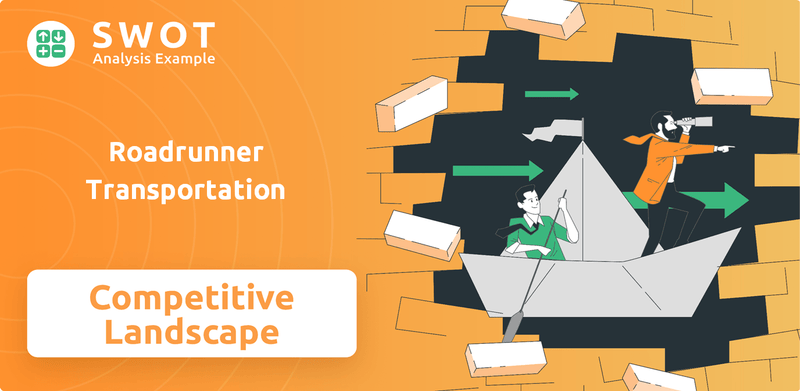
Understanding the Roadrunner Transportation Company's competitive landscape is crucial for anyone involved in the transportation industry analysis. This examination will explore Roadrunner's market position, key competitors, and financial performance. We'll also delve into its service offerings, dissecting its SWOT, and comparing it to rivals to understand its competitive advantages. Ultimately, this analysis aims to provide insights into Roadrunner's future outlook, including its expansion plans and potential challenges within the freight transportation sector.
Where Does Roadrunner Transportation’ Stand in the Current Market?
Roadrunner Transportation Company has significantly refined its market position, particularly in the less-than-truckload (LTL) segment. The company focuses on a revamped LTL service model. They aim to provide long-haul, time-sensitive LTL services across North America.
The company offers LTL, truckload, and logistics solutions. They cater to shippers needing reliable and flexible transportation. Roadrunner has invested in technology and network optimization. This investment aims to improve transit times and service consistency, differentiating them from larger logistics providers.
Roadrunner's strategic shift allows them to target customers who prioritize speed and reliability. They have also emphasized financial health through operational improvements. This contrasts with their past financial challenges. Roadrunner's current strategy indicates a strong position in its niche within the LTL market, especially for freight moving between major metropolitan areas.
Roadrunner's core operations revolve around providing LTL, truckload, and logistics services. They focus on long-haul, time-sensitive LTL shipments. Their network optimization and technology investments improve transit times, aiming for reliability.
The value proposition of Roadrunner lies in its focus on speed and reliability for LTL services. They target shippers who need dependable transportation. This is achieved through a streamlined network and advanced technology. This focus differentiates them from larger competitors.
Roadrunner's market position is centered on the LTL segment. They are strategically positioned as a provider of long-haul, time-sensitive LTL services across North America. Their focus on operational improvements and profitability is key to their strategy. You can learn more about their business model from Revenue Streams & Business Model of Roadrunner Transportation.
- Focus on LTL services for long-haul, time-sensitive freight.
- Investment in technology and network optimization.
- Emphasis on financial health and profitability.
- Targeting specific customer segments that prioritize speed and reliability.
Roadrunner Transportation SWOT Analysis
- Complete SWOT Breakdown
- Fully Customizable
- Editable in Excel & Word
- Professional Formatting
- Investor-Ready Format
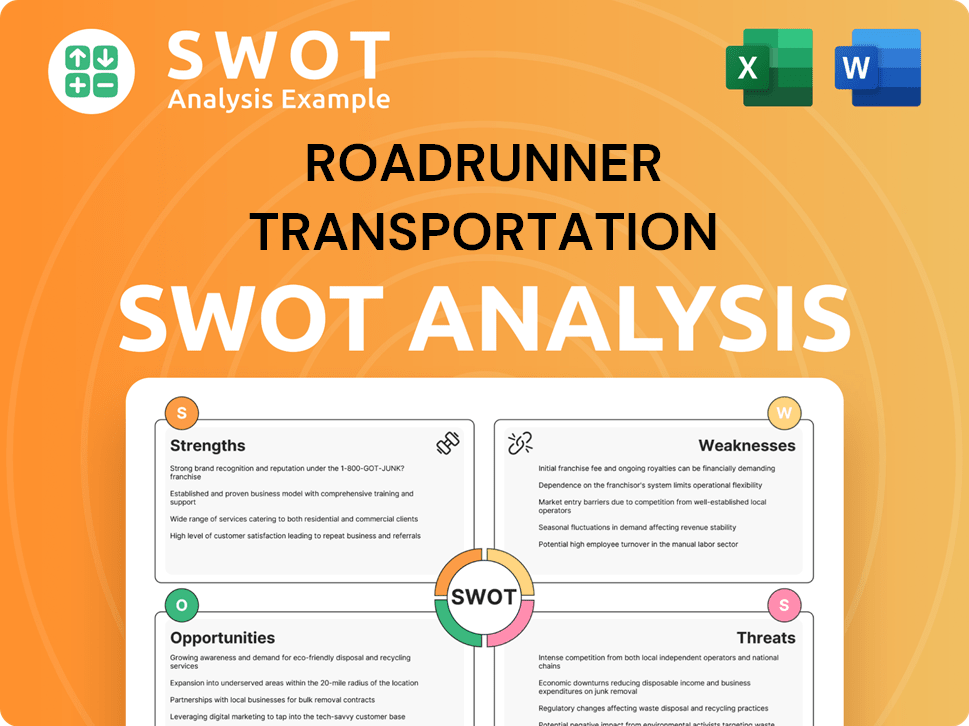
Who Are the Main Competitors Challenging Roadrunner Transportation?
The Roadrunner Transportation Company operates within a dynamic competitive landscape, primarily within the freight transportation sector. This environment is shaped by a mix of established industry giants and specialized players, all vying for market share in the less-than-truckload (LTL) and full truckload (FTL) segments. Understanding these competitors is crucial for Roadrunner to maintain its market position and develop effective strategies.
Roadrunner's competitive standing is influenced by factors such as pricing, service quality, network efficiency, and technological advancements. The ability to attract and retain drivers also plays a significant role in this industry. Emerging trends, including the adoption of advanced logistics technologies and the rise of niche market specialists, further complicate the competitive dynamics.
The competitive landscape for Roadrunner Transportation Company involves both direct and indirect competitors. Direct competitors are primarily other LTL carriers, while indirect competition comes from FTL carriers, freight brokers, and third-party logistics (3PL) providers.
Old Dominion Freight Line is a major LTL carrier, known for its extensive network and high service levels. It consistently challenges Roadrunner on service quality and transit times. In 2024, Old Dominion reported revenue of approximately $6.3 billion, highlighting its significant market presence.
XPO Logistics offers a broad portfolio of transportation and logistics services, competing across multiple segments. XPO leverages its scale and technological investments to gain a competitive edge. XPO Logistics reported a revenue of around $7.9 billion in 2024.
Saia is another significant LTL carrier, focusing on regional and inter-regional freight. It offers strong competition in specific geographic markets. Saia's revenue in 2024 was approximately $3.1 billion, reflecting its regional strength.
J.B. Hunt is a major FTL carrier, which also competes with Roadrunner, especially when shippers consider alternative modes for larger freight volumes. J.B. Hunt's revenue in 2024 was about $14.9 billion.
Schneider National is another FTL carrier that competes with Roadrunner, particularly for larger freight volumes. Schneider's revenue in 2024 was approximately $6.6 billion.
Freight brokers and third-party logistics (3PL) providers manage transportation for shippers, potentially diverting business from asset-based carriers like Roadrunner. The market share of 3PL providers continues to grow, with the top 10 providers generating over $110 billion in revenue in 2024.
Roadrunner's ability to compete effectively depends on several factors, including service quality, pricing, and technological innovation. The competitive landscape is also influenced by industry trends and the ability to attract and retain drivers.
- Pricing Strategies: Competitive pricing is essential to attract and retain customers.
- Network Efficiency: Efficient route planning and terminal operations are crucial for reducing transit times and costs.
- Technological Innovation: Investments in real-time tracking, digital booking, and other technologies can improve service and efficiency.
- Driver Retention: Attracting and retaining qualified drivers is a significant challenge in the industry.
Roadrunner Transportation PESTLE Analysis
- Covers All 6 PESTLE Categories
- No Research Needed – Save Hours of Work
- Built by Experts, Trusted by Consultants
- Instant Download, Ready to Use
- 100% Editable, Fully Customizable
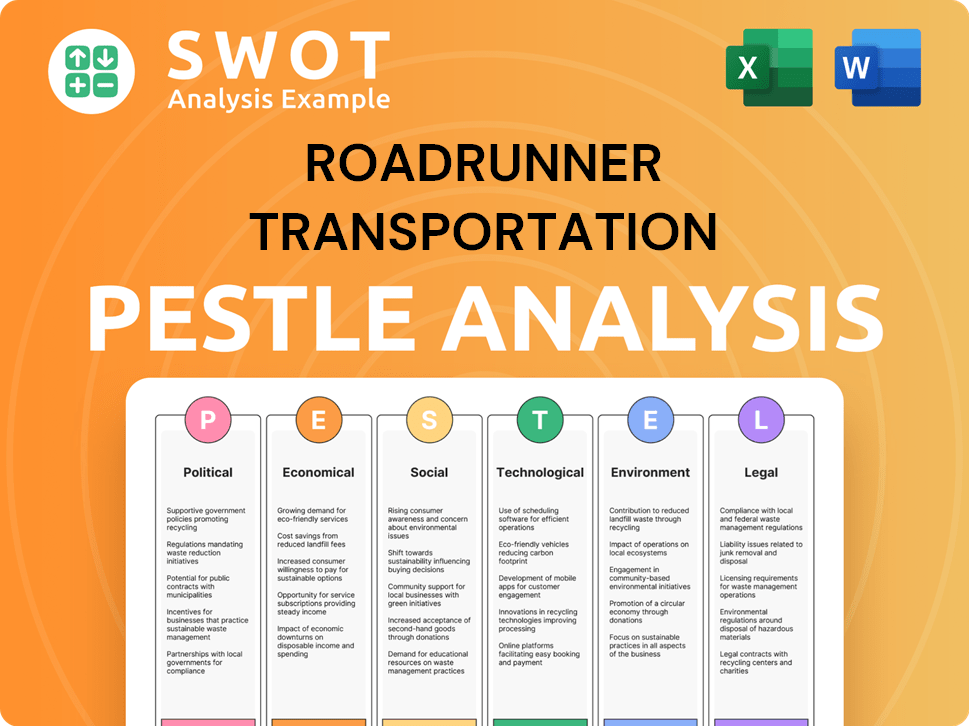
What Gives Roadrunner Transportation a Competitive Edge Over Its Rivals?
The competitive landscape for Roadrunner Transportation Company is shaped by its strategic focus on long-haul, time-sensitive less-than-truckload (LTL) freight. This positioning allows it to carve out a niche within the broader freight transportation market. Understanding its competitive advantages is crucial for a thorough transportation industry analysis, especially when considering its market position and potential for future growth. Examining its strengths relative to key competitors provides valuable insights into its operational efficiency and service offerings.
Roadrunner's approach involves leveraging technology and data analytics to optimize operations and enhance customer service. This focus allows for tailored logistics solutions, potentially leading to higher customer satisfaction and loyalty. A detailed competitor analysis is essential to understand how Roadrunner stacks up against industry rivals and to assess its ability to maintain and improve its financial performance.
A key element of Roadrunner's strategy is its commitment to a disciplined approach to freight acceptance and network density. This focus helps maintain service quality and operational integrity. Roadrunner's ability to adapt to evolving market demands and competitive pressures will be crucial for its long-term success. For more details on its strategic moves, you can review the Growth Strategy of Roadrunner Transportation.
Roadrunner's optimized long-haul LTL network is designed to provide faster transit times and more reliable service. This network optimization is a result of significant operational restructuring. This allows Roadrunner to offer a distinct service proposition compared to traditional hub-and-spoke LTL carriers.
Roadrunner leverages proprietary technology and data analytics to enhance operational efficiency. This includes improving shipment visibility and optimizing routing. These investments contribute to better service levels and potentially lower costs.
Roadrunner focuses on a specific segment of the LTL market: long-haul and time-sensitive freight. This focus enables the company to develop specialized expertise and tailor its services to the needs of these shippers. This fosters customer loyalty.
The company's commitment to a disciplined approach to freight acceptance and network density helps maintain service quality. This approach also ensures operational integrity. This is crucial for maintaining a competitive edge.
Roadrunner Transportation Company's competitive advantages stem from its optimized LTL network, technological investments, and specialized expertise. These elements work together to provide efficient and reliable services. However, the sustainability of these advantages depends on continuous investment and adaptation to market changes.
- Optimized long-haul LTL network for faster transit times.
- Leveraging proprietary technology and data analytics.
- Focus on long-haul and time-sensitive freight.
- Disciplined approach to freight acceptance and network density.
Roadrunner Transportation Business Model Canvas
- Complete 9-Block Business Model Canvas
- Effortlessly Communicate Your Business Strategy
- Investor-Ready BMC Format
- 100% Editable and Customizable
- Clear and Structured Layout
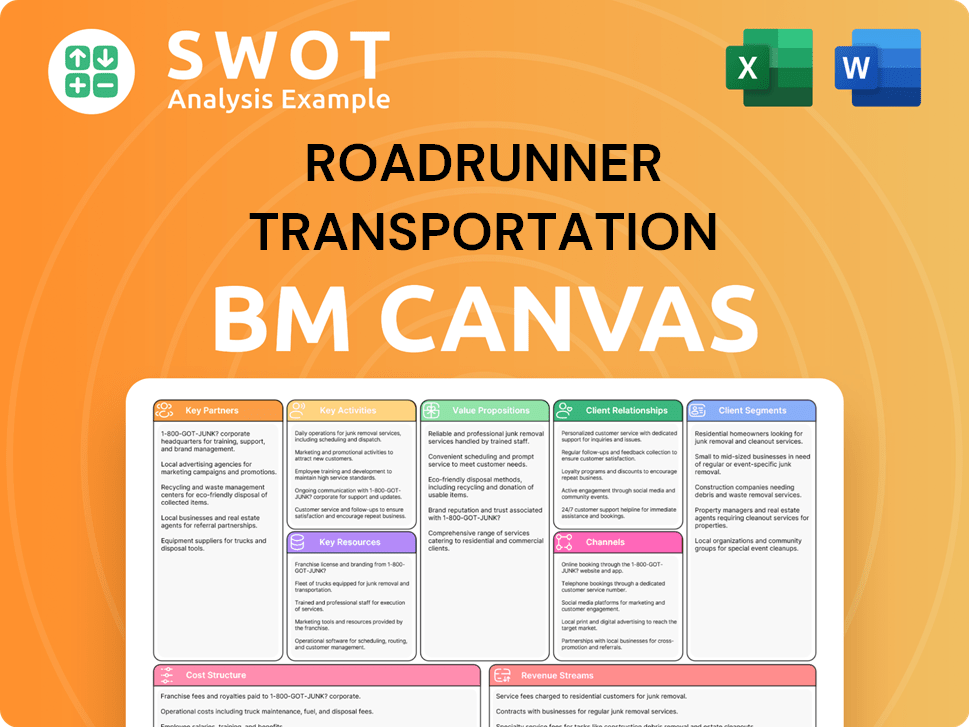
What Industry Trends Are Reshaping Roadrunner Transportation’s Competitive Landscape?
The transportation and logistics sector is currently experiencing a period of significant transformation, driven by technological advancements, evolving consumer demands, and shifting economic conditions. For Roadrunner Transportation Company, understanding these trends and their potential impact is crucial for maintaining a competitive edge. This brief history of Roadrunner Transportation highlights the company's evolution and its positioning within this dynamic environment.
The competitive landscape of the freight transportation industry is intense, with numerous players vying for market share. This analysis examines the key trends, challenges, and opportunities that will shape Roadrunner's future, providing insights into how the company can navigate the complexities of the market and achieve sustainable growth.
Technological advancements, such as AI and machine learning, are transforming route optimization and supply chain visibility. Regulatory changes, particularly those related to environmental standards and driver hours, are impacting operational costs. Consumer demand for faster and more transparent delivery services is pushing for innovation.
Intense competition from larger logistics providers with more capital resources is a significant challenge. The persistent driver shortage continues to affect capacity and operational efficiency. Rising fuel and maintenance costs also present ongoing financial pressures.
Expanding specialized LTL services to new markets could unlock new growth avenues. Strategic partnerships with shippers or other logistics providers could provide new opportunities. The increasing demand for efficient supply chains provides a fertile ground for Roadrunner to strengthen its market position.
Global economic shifts, including inflation and potential slowdowns, impact freight volumes. The ability to maintain financial agility and operational flexibility is crucial. Roadrunner's future depends on adapting to these trends and capitalizing on emerging opportunities.
Roadrunner must strategically invest in technology to improve efficiency and customer experience. Navigating regulatory changes and managing operational costs are critical for profitability. Expanding specialized services and forming strategic partnerships can drive growth.
- Technological Integration: Focus on AI and machine learning for route optimization.
- Operational Efficiency: Streamline operations to reduce costs and improve service.
- Strategic Partnerships: Explore collaborations to expand market reach.
- Market Expansion: Target new markets for specialized LTL services.
Roadrunner Transportation Porter's Five Forces Analysis
- Covers All 5 Competitive Forces in Detail
- Structured for Consultants, Students, and Founders
- 100% Editable in Microsoft Word & Excel
- Instant Digital Download – Use Immediately
- Compatible with Mac & PC – Fully Unlocked
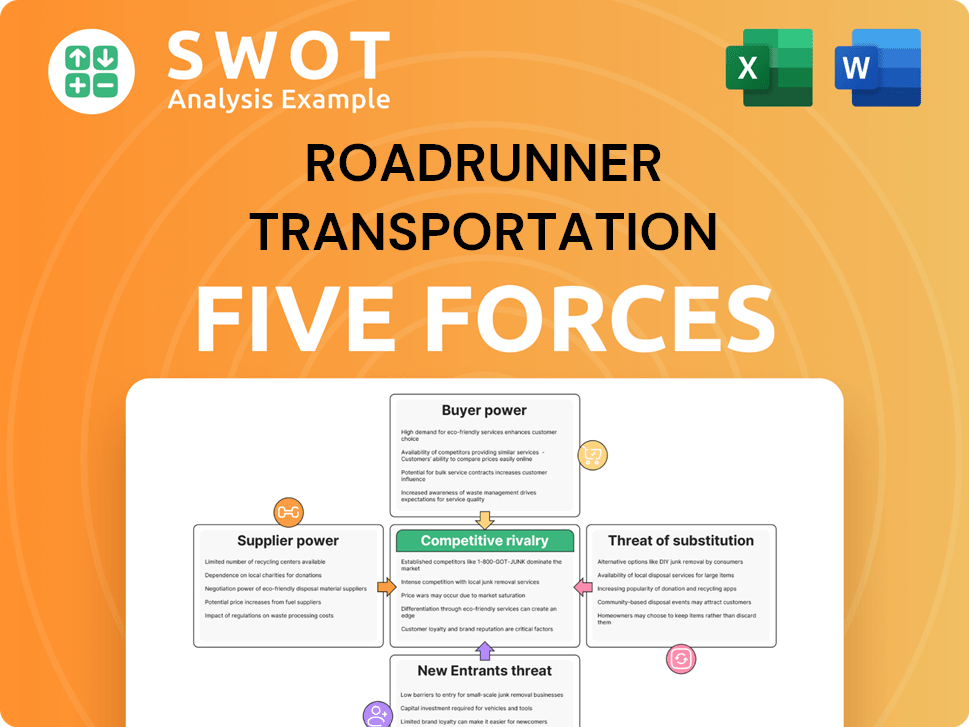
Related Blogs
- What are Mission Vision & Core Values of Roadrunner Transportation Company?
- What is Growth Strategy and Future Prospects of Roadrunner Transportation Company?
- How Does Roadrunner Transportation Company Work?
- What is Sales and Marketing Strategy of Roadrunner Transportation Company?
- What is Brief History of Roadrunner Transportation Company?
- Who Owns Roadrunner Transportation Company?
- What is Customer Demographics and Target Market of Roadrunner Transportation Company?
Disclaimer
All information, articles, and product details provided on this website are for general informational and educational purposes only. We do not claim any ownership over, nor do we intend to infringe upon, any trademarks, copyrights, logos, brand names, or other intellectual property mentioned or depicted on this site. Such intellectual property remains the property of its respective owners, and any references here are made solely for identification or informational purposes, without implying any affiliation, endorsement, or partnership.
We make no representations or warranties, express or implied, regarding the accuracy, completeness, or suitability of any content or products presented. Nothing on this website should be construed as legal, tax, investment, financial, medical, or other professional advice. In addition, no part of this site—including articles or product references—constitutes a solicitation, recommendation, endorsement, advertisement, or offer to buy or sell any securities, franchises, or other financial instruments, particularly in jurisdictions where such activity would be unlawful.
All content is of a general nature and may not address the specific circumstances of any individual or entity. It is not a substitute for professional advice or services. Any actions you take based on the information provided here are strictly at your own risk. You accept full responsibility for any decisions or outcomes arising from your use of this website and agree to release us from any liability in connection with your use of, or reliance upon, the content or products found herein.